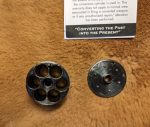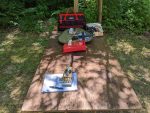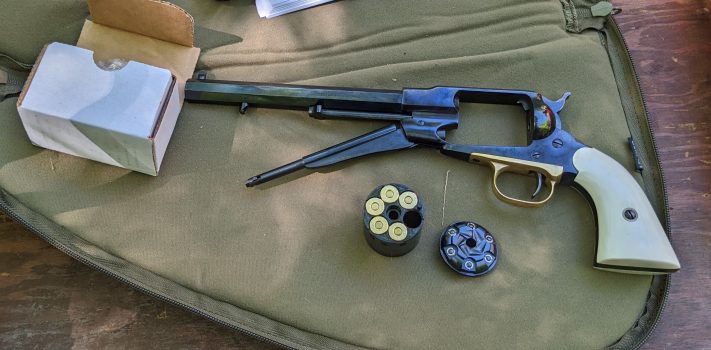I recently received a Howell Arms .45 Colt Conversion Cylinder for my Pietta M1858 cap and ball revolver. The conversion cylinder allows me to fire .45 Colt cartridges (also commonly but erroneously known as .45 Long Colt) through the revolver. After some fitting, it works extremely well, and is a lot of fun to shoot.
The Backstory
I have previously written a review in SurvivalBlog about the Pietta M1858 cap and ball revolver that I acquired from Elk Creek Company. Shooting a cap and ball revolver is a lot of fun, but loading one is somewhat time-consuming and cumbersome.
A friend knew that I wanted to try out a conversion cylinder on the revolver. He generously provided one.
Since the cylinder is a part rather than a “firearm”, it could be shipped to me via the United States Postal Service without the involvement of an FFL.
Opening the Box
 The cylinder arrived in a simple cardboard box measuring 3.75″ x 2.25″ x 2.25′. It has a sticker with a bar code and the words, “1858 Pietta .45 LC 6 Shot.” It is also stamped with the Howell Arms logo, the web address “www.howellarms.com” and the words, “Proudly Manufactured in Wisconsin.” The box contains the cylinder wrapped in plastic bubble padding, and an instruction insert with information about conversion cylinders. The backplate of the cylinder slides off, to allow the chambers to be loaded. The cylinder arrived generously oiled.
The cylinder arrived in a simple cardboard box measuring 3.75″ x 2.25″ x 2.25′. It has a sticker with a bar code and the words, “1858 Pietta .45 LC 6 Shot.” It is also stamped with the Howell Arms logo, the web address “www.howellarms.com” and the words, “Proudly Manufactured in Wisconsin.” The box contains the cylinder wrapped in plastic bubble padding, and an instruction insert with information about conversion cylinders. The backplate of the cylinder slides off, to allow the chambers to be loaded. The cylinder arrived generously oiled.
The instruction insert informed me that the cylinder is warranted for workmanship and materials for the lifetime of the original owner. It also warned against dry firing the revolver while the cylinder is installed, since this can result in damage to the firing pins.
The insert recommends only loading five rounds into the cylinder, and allowing the hammer to rest on an empty chamber. It also advises against placing fingers over the open end of the loaded cylinder when handling.
It warned that the cylinder should only be used with mild factory-loaded “Cowboy” ammunition with unjacketed lead bullets. The ammo should not exceed a muzzle velocity of 850 fps or 12,000 psi.
The insert also noted, “when you install the conversion cylinder in a replica percussion revolver to use metallic cartridges, you have manufactured a firearm.”
Fitting
I had a very difficult time convincing the cylinder pin to slide through the appropriate hole in the cylinder for the very first time. The fit was extremely tight. I wondered if I would need to send the revolver and cylinder to Howell Arms for hand fitting. After I finally wrestled the pin into place, I rotated the cylinder on the pin hundreds of times trying to help break it in.
Then, when I was ready to remove the cylinder, I had a very difficult time convincing the cylinder pin to slide out. The tolerances were just too tight.
After removal, I tried sliding a brass brush through the cylinder pin hole, running a patch with CLP through the cylinder pin hole, and lubricating the cylinder pin with CLP. This helped somewhat, but the cylinder still rotated much too stiffly, and remained difficult to insert and remove.
I continued the process of repeatedly inserting and removing the cylinder over the course of several days. There was some gradual improvement through this breaking-in process, but not enough. I was concerned that when I began to use the revolver at the range, the cylinder pin would bind up. When tolerances are too tight, the slightest bit of grit can prevent the pin from sliding smoothly in and out as it should. I was concerned that any need to manhandle the pin when the cylinder was loaded might significantly increase the risk of an accidental discharge.
As I continued to contemplate this matter, I ran across an article that was published in SurvivalBlog on January 27, 2017. The article was entitled, “Reloading and Accurizing for the 45 Colt Revolver–Part 1” by “Papa Bear”. One of the steps he described for accurizing a revolver was lapping the barrel. This involved using valve grinding compound and steel polish to polish the inside of the barrel in order to prevent irregularities in the bore from causing inaccuracy. I decided that the same process could help increase the tolerances and smooth out the inside of the cylinder pin hole in the conversion cylinder.
Accordingly, I cut a gun cleaning patch to a size that would just barely fit through the cylinder pin hole. I then placed the patch on a jag on a cleaning rod, put a small amount of valve grinding compound on the patch, and ran it back and forth through the cylinder pin hole 10 times. I then used several clean patches with kerosene as a solvent to remove any residual valve-grinding compound from the cylinder pin hole.
Next, I put some silver polish on a gun cleaning patch, and ran the patch back and forth through the cylinder pin hole until the hole was polished to a mirror finish. I then again used several clean patches with kerosene as a solvent to remove any residual silver polish from the cylinder pin hole.
Finally, I ran a dry patch through the cylinder pin hole to remove any residual kerosene, and then a patch with CLP to lubricate and protect the interior of the hole.
When I next inserted the conversion cylinder into the revolver, the cylinder pin still felt just a smidgen tight, but markedly less so than it had been prior to the lapping. I decided to allow normal use to complete the polishing process rather than risk overdoing things with any further lapping.
At the Range
 I brought the revolver and conversion cylinder to the informal range behind my barn along with a couple of boxes of Herter’s Target 250-grain lead flat-nose ammo. I set up a target stand with targets. I then set up a table with a pistol rest, fifteen yards away. I next loaded five chambers of the conversion cylinder, inserted it into the revolver with the hammer resting on the empty chamber, placed the revolver in the pistol rest, and fired five shots. This resulted in a somewhat large group about three inches high and three inches to the right of the point of aim.
I brought the revolver and conversion cylinder to the informal range behind my barn along with a couple of boxes of Herter’s Target 250-grain lead flat-nose ammo. I set up a target stand with targets. I then set up a table with a pistol rest, fifteen yards away. I next loaded five chambers of the conversion cylinder, inserted it into the revolver with the hammer resting on the empty chamber, placed the revolver in the pistol rest, and fired five shots. This resulted in a somewhat large group about three inches high and three inches to the right of the point of aim.
 I removed the conversion cylinder from the revolver, took off the back of the cylinder, and turned it upside down. Four of the five casings fell right out. One casing needed to be pried out of the cylinder. (I could have popped it out with a dowel, a pencil, or the tip of the revolver’s loading arm.) I reloaded the conversion cylinder and reinserted it into the revolver. For this second group I aimed about three inches low and about three inches to the left of the center of the target. This resulted in an adequate group clustered around the center of the target.
I removed the conversion cylinder from the revolver, took off the back of the cylinder, and turned it upside down. Four of the five casings fell right out. One casing needed to be pried out of the cylinder. (I could have popped it out with a dowel, a pencil, or the tip of the revolver’s loading arm.) I reloaded the conversion cylinder and reinserted it into the revolver. For this second group I aimed about three inches low and about three inches to the left of the center of the target. This resulted in an adequate group clustered around the center of the target.
Subsequent groups achieved similar results, whether firing from rest or off-hand.
The heavy Pietta M1858 did an excellent job of absorbing the moderate recoil of the lightly-loaded target ammunition.
Even this lightly loaded target ammunition produces a muzzle energy of 292-foot pounds. That is significantly higher than even +P loads for .380 ACP or .38 Special. This makes the revolver with this conversion cylinder a viable alternative for self-defense if better alternatives are not available. (Many state and local jurisdictions are quite restrictive, so it is nice to have a legal “no paperwork” option.)
I also discovered that the tip of the loading lever arm on the M1858 can be used to push fired cases out of the chambers of the conversion cylinder if they need a little extra persuasion.
Cleaning
After the range session, I cleaned the M1858 and conversion cylinder using kerosene as a solvent followed by CLP. I removed the trigger guard and handles to allow me better access to some parts of the revolver.
I was happy to see that there were no signs of corrosion resulting from the boiling water cleaning that I gave the revolver following my last black powder shooting session.
Conclusions
The Howell Arms conversion cylinder turned my Pietta M1858 cap and ball revolver into a firearm capable of firing metallic cartridges. This greatly enhances the usefulness of the revolver. The advantages include:
- The revolver can be reloaded much more quickly.
- Cartridge ammunition is more weather resistant than cap and ball loads.
- Smokeless powder does not obscure a shooter’s vision as significantly as black powder if follow-up shots are required.
- It is much easier to clean the revolver after it has fired cartridges with smokeless powder and non-corrosive primers than it would be after it had fired black powder.
Conversion cylinders are also available for the M1858 in .45 ACP. It seems to be harder to find unjacketed low velocity loads in .45 ACP than it is in .45 Colt.
Disclaimer
A generous friend was kind enough to provide me with the Howell Conversion Cylinder reviewed in this article. I tried not to allow his kindness to influence my assessment of the product. I believe that I have succeeded in remaining objective.
Elk Creek Company provided me with an excellent deal on the Pietta M1858 cap and ball revolver that I reviewed in a previous article.
I did not receive any other financial or other inducements to mention any vendor, product, or service in this article.










